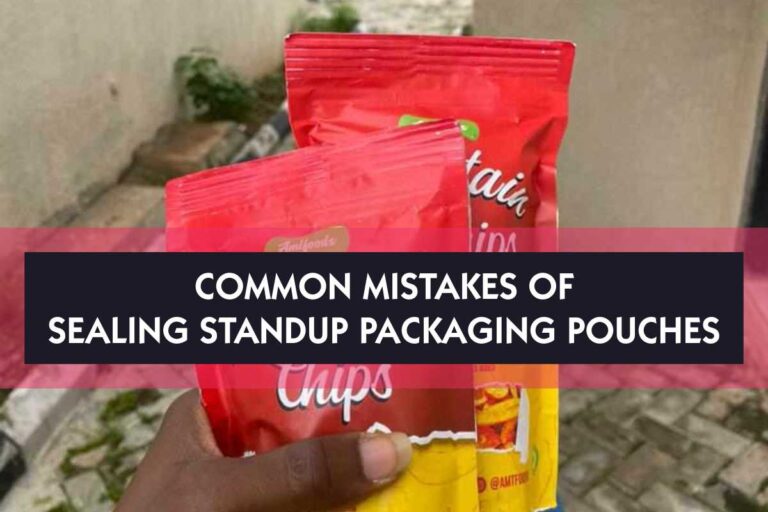From food to non-food items, standup packaging pouches are the current go-to choice for general packaging use. But despite their many benefits, it can be easy to make mistakes when sealing these pouches. If you don’t seal them properly, the contents may get spoiled, spilled, or become less appealing.
In this blog post, we will look at some of the most common mistakes people make when sealing their standup packaging pouches.
Table of Contents
Toggle10 Common Mistakes Of Sealing Standup Packaging Pouches
1. Not Removing Air Properly
One of the most common mistakes people make when sealing standup pouches is failing to get rid of enough air in the packaging before sealing. Trapped air in a packaging pouch can lead to the product spoiling faster, the bag expanding or even bursting open. Removing excess air contributes to keeping the contents fresh and also prevents the pouch from taking up extra space.
The best way to avoid this problem is to use a vacuum sealer or manually press the air out of the pouch gently as much as you possibly can before sealing. Try to make sure there is as little air left as possible before you go ahead with sealing.
2. Using Incorrect Heat Settings
Heat sealing is a common method to close standup pouches, but using the wrong heat settings can be a big mistake. If the temperature is too low, the seal may not be strong enough, and it can come undone easily. On the other hand, if the temperature is too high, it could damage the pouch material, resulting in holes or a weak seal.
Always check the recommended heat settings for the type of pouch you are using. Most pouches have guidelines for the correct temperature, so follow these instructions carefully. If you are unsure, start with a lower setting and gradually increase until you find the right level for a secure seal.
3. Overfilling the Pouch
Another common mistake is overfilling the pouch before sealing it. Overfilling can make it hard to close the pouch properly and can lead to the seal breaking. If the pouch is too full, it also increases the risk of the contents getting stuck in the sealing area, preventing a proper seal.
Leave enough space at the top of the pouch to seal it effectively. Usually, about an inch or more of space is needed for a secure seal. This way, you can be sure that there will be no leakage and that the seal will hold strong.
4. Sealing While the Pouch is Wet or Dirty
Any moisture or dirt in the sealing area can prevent the pouch from sealing correctly. If there is any product, dust, or water near the top of the pouch, the seal may not form properly, and the pouch could open up later on. This is especially true for food products that might have oil or liquid that can spread to the sealing area.
Want To Print Something?
Make sure the top of the pouch is clean and dry before sealing. Use a cloth or tissue to wipe away any dust or moisture. A clean sealing area will ensure that the pouch closes securely and helps keep your product fresh.
5. Not Letting the Seal Cool Properly
After heat sealing the pouch, it is important to let the seal cool down properly before handling the pouch. Many people make the mistake of manhandling the pouch right after sealing, which can weaken the seal. If the material is still warm and you put pressure on it, it may cause the seal to break or form improperly.
Allow a few seconds for the seal to cool and set before moving or storing the packaging pouch. This will give you a stronger, more secure seal and help prevent accidental openings.
6. Using the Wrong Type of Sealer
Using the wrong type of sealer for your standup pouches is another common mistake. Different pouches are made of different materials, and not all sealers are suitable for every type of pouch. For instance, some pouches may require an impulse sealer, while others might need a constant heat sealer.
Make sure you are using the right type of sealer for your pouch material. Check the manufacturer’s recommendations to see what type of sealer works best. Using the correct equipment will help you get a strong and reliable seal every time.
7. Ignoring the Quality of the Pouch Material
Not all standup or flat-bottom pouches are of the same quality, and using a low-quality pouch can lead to sealing issues. Thin or poor-quality pouches may not seal well or may break easily, even after being sealed. This can result in your product becoming exposed to air, moisture, or other contaminants.
Choose high-quality pouches like the one we have here at Accuxel that are designed for the type of product you are packaging. A good-quality pouch will be easier to seal and will help keep your products safe and fresh for longer.
8. Not Testing the Seal
Sometimes, people assume that once a pouch is sealed, it is good to go. However, it is always a good idea to test the seal after the pouch cools down to make sure it is secure. Failing to check the seal can lead to problems later, such as leaks or spoiled products.
After sealing and the pouch completely cools down, gently press on the pouch to check for any air leaks. You can also try to pull the sealed edges apart to see if the seal holds. This simple step can save you a lot of trouble by ensuring that your pouches are properly sealed before they are shipped or stored.
9. Sealing Too Close to the Product
If you seal the pouch too close to where the product ends, there is a higher chance that some of the product will burst when being handled in the stores or the content of the product will get caught in the seal. This is especially common when sealing powders, granules, or liquids. When the product gets stuck in the seal, it can prevent it from closing properly.
Want To Print Something?
To avoid this mistake, make sure there is enough space between the product and the sealing area. This extra space will help you create a clean and secure seal without any interference from the product inside.
10. Inconsistent Pressure While Sealing
When sealing standup pouches, the pressure applied needs to be consistent. Uneven pressure can lead to a weak or incomplete seal, which may cause the pouch to open later. This is especially true if you are using a manual heat sealer.
Make sure to apply even pressure across the entire seal area. If you are using a manual sealer, press down firmly and evenly to get a good seal. If you are using an automated machine, check the settings to ensure that the pressure is set correctly for the type of pouch you are using.
Conclusion
Sealing standup packaging pouches may seem simple, but there are many small mistakes that can lead to problems. Whether it’s not removing enough air, using the wrong heat setting, or sealing when the pouch is wet, these errors can prevent you from getting a secure seal. By understanding and avoiding these common mistakes, you can ensure that your standup pouches are properly sealed, keeping your products fresh, safe, and in good condition.
Always pay attention to the sealing process, choose the right materials, and follow the recommended guidelines for the best results. Proper sealing will not only protect your products but also improve their shelf life and ensure that your customers receive them in perfect condition.




